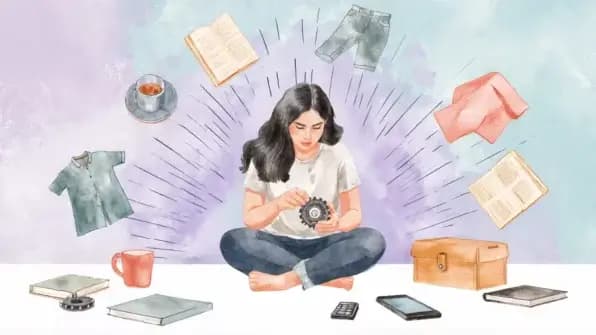TL;DR
- Autism and ADHD often occur together, and one person can experience two mental health conditions at the same time. This phenomenon is called AuDHD.
- The main ADHD and autism comorbidity symptoms are inattention, impulsivity, social communication difficulties, learning challenges, stimming behaviors, and sensory overload.
- To treat autism and ADHD together, therapists usually apply cognitive behavioral therapy (CBT), executive function therapy (EFT), social skills training, occupational therapy, and specific medications.
Unveiling the ADHD and autism overlap
Can you imagine that approximately 50-70% of people with autism spectrum disorder (ASD) display the same symptoms as ADHDer do? At the same time, 20-50% of people with ADHD also meet the criteria for ASD.
Moreover, people with one mental condition are more likely to have another than those who have neither ADHD nor autism. In fact, the rate of comorbidity of ADHD in ASD ranges from 16% to 50%.
How are autism and ADHD connected? They share common symptoms like inattention, stimming behaviors, communication difficulties, and sensory sensitivities.
Besides, these are still two separate mental health conditions that should be treated differently.
What does AuDHD mean?
There’s a term that describes autism and ADHD together. Its name is AuDHD.
It’s a dual diagnosis that applies to people who have both ADHD and ASD traits. AuDHD is an unofficial term that clinical settings don’t recognize formally.
People still deal with autistic and ADHD symptoms even if they have AuDHD. Neither ADHD nor autism manifest as “weaker than usual” when a person has two mental conditions.
This diagnosis doesn’t aim to stigmatize or minimize anyone’s experience but rather highlight the connection between two cognitive differences.
Is ADHD on the autism spectrum?
Definitely not. Even though the overlap is relatively high, recent studies state that ADHD and ASD are distinct. They can have similar symptoms but manifest differently and have different underlying neurobiological mechanisms.
AuDHD vs ADHD vs Autism
Are ADHD and autism similar? As we’ve stated above, they aren’t. However, considering all the symptoms, you may get confused and misunderstand the characteristics of each mental health condition.
It’s vital to note that people living with these diagnoses experience pretty different cognitive patterns and have non-identical behavior. So, let’s compare AuDHD vs ADHD vs ASD below.
| Autism | ADHD | AuDHD |
| Communication challenges, repeated behaviors, restricted interests | Attention issues, hyperactivity, impulsivity | Combination of the mentioned symptoms |
| Selective attention, focused on specific interests, difficulty shifting focus | Concentration problems, easily distracted | Ability to focus on specific things but easily distracted |
| Interpret everything said literally | May interrupt and talk a lot | Compounded difficulties from two disorders |
| Adherence to routines and repetitive behaviors | Put more emphasis on impulsivity | May exhibit a combination of repetitive behaviors and impulsivity |
| Are strong in very specific areas | Often quick thinkers, creative problem-solvers | Can have both ADHD and ASD traits |
| Prefer consistent and predictable lifestyle | Choose variety, creativity, and constant changes | Want to establish a routine, but may be rather impulsive |
As you see, autism and ADHD together in adults may show up quite differently and evoke various human emotions.
Sometimes, AuDHD confuses even the person living with it, creating a cognitive dissonance between two polar desires. This is why professional help is highly important.
What are AuDHD symptoms?
Let’s remember the main character of The Big Bang Theory, Sheldon Cooper. He hyper-focuses on specific things, has repetitive behavior, struggles to understand social tendencies, and feels awkward communicating with others.
These are autism and ADHD comorbidity symptoms. Now, let’s focus on each one separately and discover what makes the experiences of people with AuDHD diagnosis unique.
1. Inattention
You are in a constant rush to do something here and now. There’s no time to focus on one task; too many things are missing.
Have you had a classmate who always was finding it difficult to focus on the lessons and was too active talking and doing everything except studying? Although his academic performance might be rather high, it was challenging for him or her to spend hours listening to teachers.
Even though it might be an educational problem, this classmate could also face ADHD, autism, or their overlap. Here are a few warning signs that allow therapists to recognize a diagnosis.
- Excessive physical activity or talking
- Urge to interrupt other people
- Impatience or difficulty waiting for one’s turn
- Inability to sit still, constant need to move
- Restlessness
Noticing these symptoms, some parents consider their children fidgets and scold them for it. You might find it very hard to get through this, and it did not even help. ADHD and autism are diagnoses that need professional support, while the combination of ADHD & trauma can even worsen the symptoms.
If you need extra support to address it, contact a therapist. Expert treatment will help you deal with the challenges in the present and traumatic experiences from the past.
2. Impulsivity
You can feel an instant urge to buy a one-way ticket to San Francisco, get a tattoo, or spend all your salary on new clothes in less than 30 minutes.
While some of these ideas may sound fun, there’s a huge difference between being easy-going and making important decisions thoughtlessly. The borders are quite blurred. However, when the first trait brings you great memories, the second one could make you regret your actions.
Autism and ADHD overlap might influence you to act more aggressively, engage in dangerous behavior, and abruptly change or cancel plans. Additionally, there is a high likelihood of binge eating, substance misuse, impulsive decision-making, and other challenges.
3. Social communication difficulties
There are statistics that around 38% of children and adolescents with ADHD have social anxiety disorder (SAD). At the same time, 50% of people with ASD deal with SAD as well.
As you see, social interaction challenges are another key aspect of AuDHD’s meaning. If you have ADHD and autism comorbidity, it may be difficult for you to establish and maintain relationships with others.
The positive thing is that appropriate therapy and a personalized approach from a licensed expert can make your healing journey much simpler. SAD isn’t a mandatory accompaniment of AuDHD and isn’t a verdict. You can live life to the fullest with an AuDHD diagnosis.

4. Learning challenges
Do you remember the movie “Rain Man” with the main character Raymond Babbitt? The man faces significant learning challenges because he has autism and co-existing ADHD traits.
Besides, AuDHD may cause him not only difficulties but also exceptional memory and proficiency in certain cognitive tasks, like counting and calculating.
The real situation is pretty similar. Autism and ADHD comorbidity make it tough for people to learn, as most of us do. However, they can unlock their potential and achieve remarkable success with the proper support of their neurodevelopmental differences.
5. Stimming behaviors
Does taking a 2-hour gym training sound simpler for you than sitting a 2-hour course at the university? If yes, it may be a symptom of the ADHD spectrum.
It feels like a constant urge to do something, no matter what. You need to move and can’t sit still longer than for a few minutes.
What is stimming? Let’s look at some examples.
- Swinging back and forth
- Blinking repeatedly
- Snapping fingers
- Saying the same words or phrases repeatedly
- Pulling hair
- Rubbing or scratching the skin
Of course, it can be just a habit that has nothing in common with ADHD and autism comorbidity. It’s important to pay special attention to your mental health if you have other symptoms as well.
6. Sensory overload
Autism-connected sensitivity and ADHD-related impulsivity may lead to overstimulation and sensory overload.
Have you ever felt overwhelmed on a street with too many loud noises, lights, and people around? Or, maybe it’s difficult for you to visit concerts, airports, and other crowded places. That’s it!
Everyone can be overstimulated. Besides, people who deal with ADHD and autism are more likely to experience these symptoms. This is why the film, “Extremely Loud & Incredibly Close,” about a 9-year-old boy with ASD, has this name.
Does autism and ADHD comorbidity feel similar to everyone?
While people living with AuDHD may deal with many symptoms of both mental health conditions, every case is unique. Like there are no similar snowflakes in the whole world, there are no identical situations either.
At the same time, two main patterns remain the same: difficulties with focusing on something and displaying very intense emotions.
AuDHD in women and men is also different. Moreover, everyone experiences various combinations of the traits above, and their intensities are also non-identical. And, of course, the manifestations of symptoms are entirely dissimilar to the ones in people who don’t face autism and ADHD comorbidity.
Do you deal with ASD but feel that the traits above resonate with your experience? Maybe it will be reasonable to test your ADHD and autism comorbidity.
Take an ADHD screening test and gain personalized insights into your cognitive traits and potential areas of overlap between these diagnoses.
What’s AuDHD’s positive side?
Some unique combinations of AuDHD characteristics can even empower their owners. An interesting problem-solving approach is one of them.
Hannah Schlueter states, “It is crucial to remember that ASD and ADHD come with their own strengths and superpowers, which can and should be recognized, utilized, and celebrated!”
People with ADHD or autism often have unique thinking styles, which allow them to deal with complex problems in creative ways. This can lead to innovative solutions that others might not consider.
Difficulties with diagnosing autism and ADHD together in adults
Because of symptoms that overlap, therapists can have difficulties identifying that a person has both diagnoses. Often, it may be challenging to notice from the spot that someone deals with more than just ADHD or ASD.
So, if you feel that your mental health condition doesn’t describe your experience comprehensively, it will be reasonable to ask your therapist to test you for autism and ADHD together. You’ll study your symptoms more attentively, as this combination can have diverse manifestations.
Sometimes, high-functioning autism and ADHD in adults may have coexisting conditions like anxiety or depression. It’s vital to stay open with your therapist to avoid misunderstandings when identifying the diagnosis.
AuDHD treatment approaches
Hannah Schlueter comments, “The recent increase of ASD and ADHD diagnoses shines a light on the need for personalized approaches to those with neurodiversity. Seeking professional help can mitigate the amount of frustration and helplessness that often accompanies either diagnosis while creating a more effective system for you to succeed in your day-to-day life.”
Gone are the days when people with ASD or ADHD didn’t receive appropriate treatment and were forced to act like those without cognitive differences. Now, supporting your needs and providing actual healing is what you can get from a licensed expert.
Even though navigating the complexities of this dual diagnosis may seem challenging, it’s still more than possible. People who are being treated for high-functioning autism and ADHD in adults need a specific approach and personalized plans to navigate their cognitive differences.
Therapists create safe environments for people with autism and ADHD, where you don’t need to hide your actual feelings and states. Further, I provide the most widespread approaches to healing a combination of these diagnoses.
Cognitive behavioral therapy (CBT)
This approach concentrates on changing destructive thoughts and behaviors to adaptive ones. If you experience ADHD burnout, feel exhausted from the traits of the mental health condition, or want to manage your emotions better, that’s it.
You’ll gradually learn to deal with autism and ADHD comorbidity symptoms and change your thought patterns. It’s also possible to improve focus and manage impulsivity much better.
Executive function therapy (EFT)
This approach focuses on improving cognitive skills and strengthening focus. For people with autism and ADHD, it will be helpful to improve time management and memory, and learn to be more organized.
Choosing this approach as empowerment to CBT therapy may be the best option for people with AuDHD.
Social skills training
High-functioning autism and ADHD in adults can bring many challenges to daily life, especially in interpersonal interactions. Social skills training will help you establish strong, long-term connections and communicate with others effectively.
It’s important for people living with ADHD that such therapy happens in a safe and supportive environment. This will help you enhance your ability to navigate social situations and develop meaningful relationships with others, contributing to a more fulfilling and connected life.
Occupational therapy
This is a helpful approach that allows people with autism and ADHD comorbidity to manage daily tasks more effectively. A therapist will help you cope with hypersensitivity and overcome overstimulation more easily.
These things aim to improve your life in society and help you gain independence in all your daily activities. By addressing specific challenges related to sensory processing and organization, you will gain valuable skills to navigate environmental challenges with greater confidence.
Medication
Last but not least. Sometimes, autism and ADHD together manifest in symptoms that are difficult to manage without appropriate medication.
There’s nothing wrong or terrible with taking pills prescribed by a licensed professional. They aim to help people overcome accompanying issues and specific traits, ultimately enhancing their quality of life. It’s essential to work closely with a healthcare professional to find the right treatment approach tailored to individual needs.
Let’s recap
Now you can confidently answer the question, “What is AuDHD?”, understand the connection between ADHD and autism, and know the symptoms of their combination.
If you are related to the information in this article, take care of your mental health and visit a therapist to take an AuDHD test and screening. Professional treatment will help you deal with the symptoms and pave the way to a more fulfilling life.
Additionally, you can take Breeze’s well-being profile assessment to get personalized insights on how to improve your mental health and get happier no matter what diagnosis you have.
Disclaimer
This article is for general informative and self-discovery purposes only. It should not replace expert guidance from professionals.
Any action you take in response to the information in this article, whether directly or indirectly, is solely your responsibility and is done at your own risk. Breeze content team and its mental health experts disclaim any liability, loss, or risk, personal, professional, or otherwise, which may result from the use and/or application of any content.
Always consult your doctor or other certified health practitioner with any medical questions or concerns
Breeze articles exclusively cite trusted sources, such as academic research institutions and medical associations, including research and studies from PubMed, ResearchGate, or similar databases. Examine our subject-matter editors and editorial process to see how we verify facts and maintain the accuracy, reliability, and trustworthiness of our material.
Was this article helpful?







